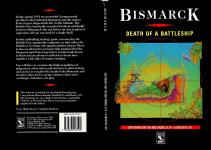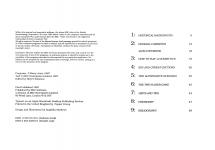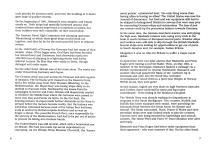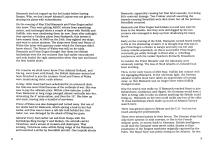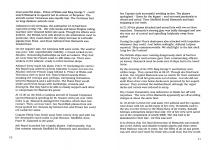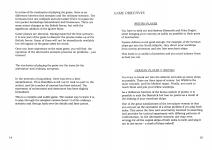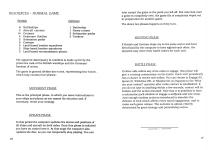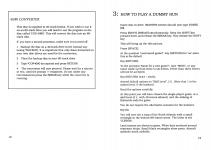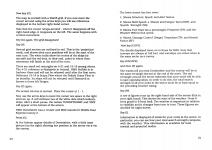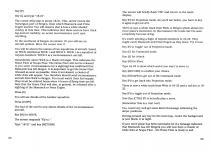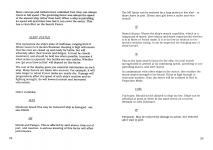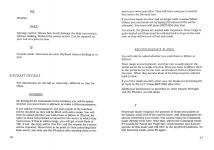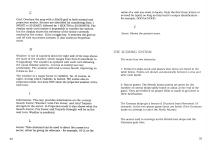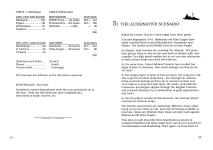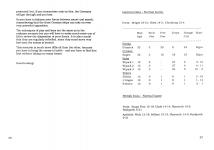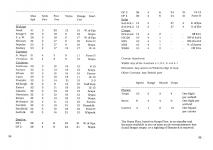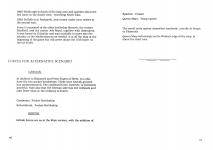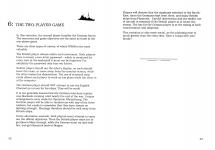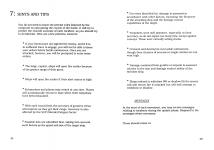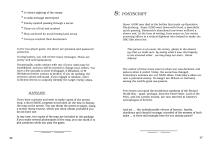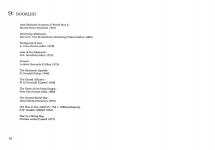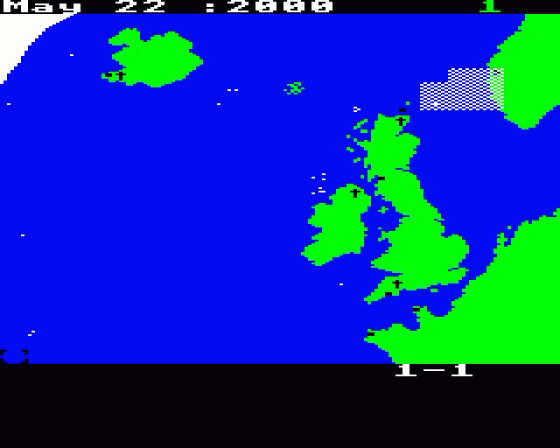
| Genre: | Unknown Genre Type |
| Publisher: | BBCSoft/BBC Publications |
| Cover Art Language: | English |
| Machine Compatibility: | BBC Model B, BBC Model B+, BBC Master 128 |
| Release: | Professionally released on 5.25" Disc |
| Available For: | BBC B/B+/Master 128 |
| Compatible Emulators: | BeebEm (PC (Windows)) PcBBC (PC (MS-DOS)) Model B Emulator (PC (Windows)) |
| Original Release Date: | 3rd January 1988 |
| Original Release Price: | £16.99 |
| Market Valuation: | £4.00 (How Is This Calculated?) |
| Item Weight: | 234g |
| Box Type: | Cardboard Box (Decorative) |
| Author(s): | Barry Joyce |
Variant Items
There are 0 other items featuring this same game (that we know about!). Click any of them for their details.
Active Auctions
Closed Auctions
Buy It
Unfortunately no-one is currently selling this item.
Inner Inlay
Auction Price Watch
Worried you're being ripped off? Closing prices on eBay can help you decide what a reasonable price is for a particular item.

The Micro User
1st May 1988
Bismarck is a definite must for those of you who like wargames, but I also think that quite a few others will be pleasantly surprised at this fascinating game. Read Review
Full Instructions
Bismarck: Death Of A Battleship
In late spring 1941, two powerful German naval predators, the battleship Bismarck and the cruiser Prinz Eugen, slipped into the North Atlantic. The British Navy frantically searched for them and finally destroyed Bismarck, but not before its own symbol of supremacy, Hood, was sunk by a single shell.
In this enthralling strategy game, you can play the British Navy against the computer, or take either the British or German role against another player. There is also an alternative scenario that assumes that the Bismarck and Prinz Eugen have reached safe haven at Brest and are about to sail back to home base together with other German warships.
You will have to exercise the highest qualities of judgement, observation and decision to plan strategy and tactics as you plot the death of the Bismarck and its sister ships and so create a history that varies excitingly each time you play.
Dedication
These notes are affectionately dedicated to my son, Charles, whose model of Bismarck graced my study for many years.
Historical Background
In the Autumn of 1918, the undefeated German Grand Fleet surrendered to the Allies. It was anchored at the British base of Scapa Flow in the Orkneys; and there its crews scuttled their ships rather than deliver them into the hands of the victors of the war on land.
Then, between the two world wars, the proud establishment, of the German navy struggled to preserve its traditions; and, after Hitler came to power, strove to restore its former glory.
Hitler was no seaman. "A hero on land but a coward on sea," he described himself as in a moment of unwonted modesty. His admirals, Raeder and Doenitz, were Germans not Nazis. They even succeeded in retaining Jewish officers in their fleets while the nazified German army was busy devouring its own.
However, Hitler still grasped some notion of the blockade threat posed by British sea-power and planned to meet it. Sadly for the German navy, he did not understand that it takes ten years to build a fleet of battleships. Raeder and Doenitz planned for a war beginning in 1946; but their master could not wait.
When he first started to re-arm, he laid down the pocket-battleships Graf Spee, Scharnhorst and Gneisenau. These were heavily armed but lightly armoured to keep their weight within the limits of treaties that Hitler was as yet unready to break.
Then, in the later 30's, work started on the Bismarck and Tirpitz. These were to be the most powerful and heavily armoured ships afloat. Subsidiary cruisers (such as Hipper and Prinz Eugen) were also laid down, for without their protective company no captial ship could survive for long. The shipyards also began work on an aircraft carrier (which was never completed). Construction was slow because tanks and trucks took priority for precious steel, and even the building of U-boats gave hope of quicker returns.
By the beginning of 1941, Bismarch was complete and Tirpitz nearly so. Both ships had specially hardened armour that rendered them almost impervious to torpedoes or mines; but their rudders were still vulnerable, as time would show.
The German Naval High Command was planning operation "Rheinubung" in which these great ships would break out together, and then be by far the most powerful force in Atlantic waters.
In the 1940 battle of Norway the Germans had lost many of their smaller ships Of the bigger ones, Graf Spee had been scuttled; but Scharnhorst and Gneisenau had afterwards sunk over 100,000 tons of shipping in a lightning winter raid led by Admiral Lutjens. By May they were safely in Brest, though damaged and under repair.
On the other hand, Britain was at her most alone. The world was under threat from Germany and Japan.
The German Army was just across the Channel and still capable of invasion. The Germans were massed on the Eastern Front, still a few weeks away from their Russian Blitzkrieg. In the Mediterranean, the Royal Navy was losing ships daily in its attempt to evacuate Crete, Britain still desperately needed to reinforce the Middle East where the Germany were poised to move into Iraq and Persia via Syria. In the Far Easy, the looming menace of Japan made further demands on the Navy to prepare before the menace of Japan made further demands on the Navy to prepare before the menace became reality. But the balance was somewhat redressed because most of the Italian fleet had been sunk at anchor by British torpedo-bombers and so was no longer a threat. The powerful French fleet, once responsible for the security of the Mediterranean, had had to be put out of action to prevent its falling into German hands.
The United States was still neutral, albeit with a benevolent eye on Britain. She had just made top-secret experiments in convoying. As the British Prime Minister Churchill, the 'former naval person', commented later, 'the only thing worse than having allies is having no allies!' The United States was now the 'arsenal of democracy', but food and war equipment still had to be shipped to beleagured Britain in convoys that were easy prey for marauding German ships and submarines. The loss of just one convoy could tip the precarious balance towards Germany.
At the same time, the German merchant marine was still plying the high seas. Blockade runners were using every trick in the book to reach German or European neutral ports. Weather ships and tankers were still able to slip through the British blockade. Several ships were looking for opportunities to get out of ports in South America and, for example, Italian Eritrea.
Altogether it was no time for Britain to suffer a major naval defeat.
In April there were two false alarms that Bismarck and Prinz Eugen were moving out of the Baltic. Then, on May 18th, a member of the Norwegian resistance flashed a message via a British representative in neutral Stockholm: Bismarck and another ship had passed the Skaw at the northern tip of Denmark and were into the North Sea. Intensive reconnaissance found them in a fjord near Bergen in Norway. Within hours, they were gone!
At this season, nights are very shot in high Northern latitudes and, further, there could still be snow and fog to give concealment - if the timing of the breakout was good.
The British Navy was already making its dispositions in response to the latest intelligence. Two cruisers, Norfolk and Suffolk (the latter equipped with radar), were patrolling the Denmark Strait between the Great Arctic Ice Barrier and Iceland. The Strait was mined. Hood, Prince of Wales and their most powerful ships - Prince of Wales and King George V - could match Bismarck in speed if not in armour or firepower. The aircraft-carrier Victorious was equally fast. The Germans had no long-distance aircraft cover.
Unknown to the Germans, the submarine U110 had been captured on May 7th. Her code-books and latest Enigma coding machine were removed before she sank. Though the effects were indirect, the British were well ahead in the information race! In particular, they could observe the sharp increase in Luftwaffe signals from Brest, and these indicated that Bismarck was headed there.
On the negative side, the Germans held some cards. The weather was poor, with unpredictable visibility. U-boats lurked in the Atlantic, threatening battleships as well as tankers. They had air cover from the French coast to 400 miles out. There were tankers in the Atlantic, ready to refuel German ships.
Admiral Tovey made his plans. Force 'H' (including the carrier, Ark Royal) was ordered up from Gibraltar to move out into the Atlantic with the French coast behind it. Prince of Wales and Victorious were to move S.E. from Iceland towards Brest - masking the convoys and, perhaps, interposing themselves between Bismarck and a safe haven. The Home Fleet would strike south from Scapa with battleships, cruisers and destroyers. But they had to be able to closely support each other to compensate for Bismarck's power.
At 10.30 on the 26th a Catalina aircraft of Coastal Command spotted Bismarck speeding for Sr. Nazaire with just over 1000 miles to go. Bismarck damaged the Catalina, which then lost contact. Then, an hour later, two Swordfish planes from Ark Royal spotted her. Renown lay between her and France but could not tackle her alone.
Captain Philip Vian broke away from convoy duty and with his five destroyers raced north to join Renown. Sheffield, from Force 'H', hastened to the scene.
Ark Royal launched her torpedo-planes. Unfortunately, this first mission mistook Sheffield for Bismarck and attacked, but her Captain took successful avoiding action. The planes apologised - "Sorry for the kipper" - and returned penitently to reload and refuel. Then Sheffield found Bismarck and kept snapping at her heels.
At 21.30 the planes attacked and scored hits with two or three torpedoes. Bismarck's steering gear was badly damaged and now she was out of control and spiralling helplessly away from safety!
During the night Vian's destroyers also attacked with torpedoes whenever they could. Just before midnight, Admiral Lutjens reported, "Ship un-manoeuvrable. We shall fight to the last shell. Long live the Fuehrer!"
The British ships were running dangerously short of fuel but Admiral Tovey's instructions gave their commanding officers no leeway. Bismarck must be sunk even if ships had to be towed home.
By the morning of the 27th King George V and Rodney were within range. They opened fire at 08.47. Though she fired back at first, the crippled Bismarck was no match for their combined might. By 10.15 all her guns were out of action - but she did not sink! Most of her crew below decks were protected by her superb armour. They survived the bombardment although the upper decks and turrets were reduced to scrap.
The cruiser Dorsetshire was ordered in to finish her off with torpedoes. The crew of the Bismarck apparently set off scuttling charges at about the same time.
At 10.40 she turned over and sank. Her admiral and her captain went down with her, as did many of her crew. Hundreds too to the sea, but the threat to the Royal Navy of (in reality, distant) German submarines meant that only 110 of her crew were saved out of the complement of nearly 2,000. The rest had to be abandoned to their fate - for this was war!
It is obvious that the final destruction of Bismarck was mainly due to the elderly and obsolete torpedo planes and their crews. Pearl Harbour was yet to come, but the effect of air on sea power was writ clear once more for those who could read. But few could, and Prince of Wales herself was to be lost to Japanese naval aircraft before the year was out.
Prinz Eugen joined Scharnhorst and Gneisenau and together they made a dramatic and successful dash back to Germany. At the end of the war Prinz Eugen was handed over to the American Navy and ended her days ignominiously in the Pacific as a target ship for atomic weapons.
(Note: there are differences of timing in the records. The Royal Navy sometimes used GMT, sometimes 1 hour of British Summer Time, and sometimes two hours. The Germans sometimes used GMT, but also used Central European Time.)
General Comments
In the instructions, all keys are shown in square brackets: [ ]. Where a specific key is meant, it is shown as a word within square brackets, thus: [ESCAPE]. If a word is to be typed in, it is shown in quotes; thus : "MINE".
One-Player Game
In the one-player game you command the Allied fleet in the North Atlantic and the computer is your opponent. Your mission is to sink the Bismarck before she can destroy the convoys or escape to Brest to be a standing threat.
Two-Player Game
Your opponent has to sink shipping and get his capital ships back to Germany.
Alternative Scenario
For both the one-player and two-player games, this scenario includes the Queen Mary, which was used as a troop transport. Further, the dispositions of the British ships, and their numbers and names, are somewhat different, and the German ships Bismarck, Scharnhorst and Gneisenau start from Brest with the Baltic as their destination. The Prinz Eugen is also part of the German force.
In terms of the mechanics of playing the game, there is no difference between this scenario and the ordinary scenario. The Germans have one wolfpack and one tanker fewer, but gain the two pocket-battleships Scharnhorst and Gneisenau. There are some minor changes in the British forces, but with the significant addition of the Queen Mary.
Game phases are identical. Having mastered the first scenario, it is now part of the game to discover the precise make-up of the British forces. Some of them will not be immediately available but will appear as the game takes its course.
Once you have experience in the main game, you will find the operation of the alternative scenario presents no problems - just interest!
The mechanics of playing the game are the same for the alternative and ordinary scenarios.
In the interests of playability, there has been a little simplification. Thus Ramillies is left out (it took no part in the action), and the number of convoys has been reduced. The movement of submarines and destroyers has been slightly formalised.
This is a complex and subtle game. The easiest way to learn it is to play through the simplest version (Level 1) of the ordinary scenario and then go back over the details and finer points.
Game Objectives
British Player
You have to seek out and destroy Bismarck and Prinz Eugen, while bringing your convoys as safely as possible to their ports of destination.
Passive defence is not good enough. For example, if the German ships get into the North Atlantic, they divert your warships from convoy protection and you lose merchant ships.
This leads to a conflict of priorities and you must balance these as best you can.
German Player V British
You have to break out into the Atlantic and sink as many ships as possible. There are three types of convoy but WS8B is the most valuable, and the likeliest target. Finally, you need to reach Brest and join your fellow warships.
As a deliberate function of the bonus system of points, it is possible to sink the Bismarck but lose on points as a result of the sinking of your merchant ships.
One of the great satisfactions of the two-player version is that you can set up the equivalent of a chess problem if you play both sides. This saves the time and uncertainty involved in searching and provides for tactical experiment with differing patterns of confrontation. In the alternative scenario, one may even arrange for all the capital ships of both sides to meet and slog it out in one sector - a clash of titans indeed!
Resources: Normal Game
| British | |
| 6 | Battleships |
| 2 | Aircraft carriers |
| 14 | Cruisers |
| 4 | Destroyer flotillas |
| 2 | Submarine Packs |
| 5 | Convoys |
| 3 | Land-based bomber squadrons |
| 2 | Ship-based bomber squadrons |
| 3 | Land-based reconnaissance planes |
| German |
|
| 1 | Battleship |
| 1 | Heavy Cruiser |
| 3 | Submarine packs |
| 3 | Tankers |
The apparent discrepancy in numbers is made up for by the protective task of the British warships and the German's freedom of action.
The game in general divides into turns, representing four hours, which may contain four phases:
- Movement Phase This is the principal phase, in which you issue instructions to your ships and planes as you assess the situation and, if necessary, revise your strategy.
-
Update Phase
In this period the computer updates the status and positions of all ships and aircraft on both sides. Once this phase is initiated, you have no control over it. At this stage the computer also updates the disc, so you can temporarily stop playing. You can later restart the game at the point you left off. But note that once a game is completely over, the game file is completely wiped out in preparation for another game.
The above two phases happen every turn. -
Sighting Phase
If British and German ships are in the same sector and have been found by the computer to have sighted each other, the player(s) may enter their battle orders for each unit. -
Battle Phase
If either side orders any of its units to engage, this phase will give a running commentary on the battle. Each unit periodically has a chance to receive new orders. You can choose to Engage (E), Ignore (I), Withdraw (W) or Shadow (S), in response to the 'What are your orders?' question after radio contact is established. If you do not type in anything within a few seconds, contact will be broken and the action resumed. Note that it is pointless to have a submarine pack shadow or engage a wolfpack and vice versa. Just enough random action is introduced to simulate the element of luck which affects every naval engagement, and to make each game unique. The outcome is almost entirely determined by good strategy and painstaking tactics.
40/80 Converter
This disc is supplied in 40-track format. If you wish to use it on an 80-track drive you will need to use the program on the disc called 'CON4080'. This will convert the disc into an 80-track disc.
If you have a second processor, make sure it is turned off.
- Backup the disc on a 40-track drive in the normal way (using *BACKUP). It is important that only discs formatted on your own disc drives are used for the conversion.
- Place the backup disc in your 80-track drive.
- Type *CON4080 (no spaces) and press RETURN.
- The conversion will now proceed. Please wait for a minute or two, until the prompt '>' reappears. Do not under any circumstances press the BREAK key while the converter is running.
How To Play A Dummy Run
Insert disc in drive. (Master owners should now type [*DISK] [R]).
Press [SHIFT][BREAK] simultaneously. Keep the SHIFT key pressed down and release the BREAK key. Now release the SHIFT key.
This will bring up the title picture.
Press [SPACE].
At the question 'Load saved game?', key [RETURN] for 'no' since this is the default.
Key [RETURN].
To the question 'Name for a new game?', type "MINE", or any name made up from three to six letters. Fewer than three letters will not be accepted.
Key [RETURN] twice - slowly.
Amend default options to "Skill Level", [1]. (Note that 1 is the easiest level, 5 is the hardest.)
Read the options carefully.
At this point you will have chosen the single-player game; at a skill level of 1; with 40 moves allowed; and the sinking of Bismarch ends the game.
You do not require the alternative scenario for the moment.
Key [S].
You will now see a map of the North Atlantic with a small rectangle in the bottom left-hand corner. The latter is the 'CURSOR'.
Land masses are shown in green. White dots scattered around represent ships. Small black rectangles show ports. Aircraft symbols mark airfields.
Now key [G].
The map is overlaid with a 20 x 25 grid. If you now move the cursor around using the arrow keys you will see references displayed in the bottom right-hand corner.
Note that the cursor 'wraps-around' - when it disappears off the right-hand edge, it reappears on the left. The same happens with vertical movement.
Key [G] again. The grid disappears!
Key [P].
Several grid sectors are outlined in red. This is the 'projection' mode, and shows what your positions will be at the start of the next turn. The white trails show the routes of the ships (or aircraft) and the red dots, at their end, point to where their movement will finish at the end of the turn.
There are small red rectangles on 4-21 and 15-19 among others. The 4-21 reference is Reykjavik in Iceland. HMS Suffolk is in harbour there and will not be released until after the first move. Reference 15-19 is Scapa Flow where the British Home Fleet is on standby. Its ships will not be released until Bismarck is known to have left Bergen.
Key [P] again.
The screen returns to normal. Press the cursor at 1-1.
Now use the arrow-keys to move the cursor one space to the right and two up. It will embrace two of the white dots which indicate ships. After a short pause, the names 'DORSETSHIRE' and 'MX2' will appear at the bottom of the screen.
HMS Dorsetshire was a cruiser and MX2 stands for Middle-East Express Convoy 2.
Press [C].
At the bottom appear details of Dorsetshire, with a little inset picture (on the right) showing her position in the sector vis-a-vis the convoy.
The lower screen has four rows:
1: Shows Direction; Speed; and Alert Status.
2: Shows MAX Speed; a 'Morale and Fatigue' factor (MF); and 'Search Strength' (SS).
3: Shows Fuel State (as a percentage); Firepower (FP); and the Weather (WE) in that sector.
4: Shows 'Damage Control' (Dmge); Torpedoes (TP); and Search Factor (SF).
Now key [COPY].
The details displayed move on to those for MX2. Note that convoys are always at full fuel, and warships can refuel when in the same sector as a convoy.
Key [ESCAPE]
and then [P] again.
The tracks tell you that Dorsetshire and the convoy will be in the same rectangle (sector) at the end of the move. The red rectangle around the sector indicates that your units will be able to spot opposing ships. In order to do this, the total search strength of all your units in the sector must be at least equal to the prevailing weather rating.
Key [W].
A row of figures runs up the right-hand side of the screen (that is, your right hand). This shows the state of the weather - from 0 (very good) to 9 (very bad). The weather is important in relation to visibiliity and it changes from turn to turn. These figures are doubled for night moves.
Key [I].
Information is displayed of totals for your units in the sector. In particular, you can see how your total search strength compares with the weather. This information is available for both normal and projected modes.
Key [P].
Key [L] and type "18-21".
The cursor will jump to sector 18-21. This sector covers the Norwegian port of Bergen, from which Bismarck and Prinz Eugen started. You will observe that it has a while shaded overlay at this time. This indicates that these sectors have thick fog and nil visibility, so aerial reconnaisance can't spot anything.
To the southwest of Bergen, in column 15, you will see an aircraft symbol. Move the cursor over it.
You will be shown the names of two squadrons of aircraft, based on WICK, labelled as WICK 1 and WICK 2. WICK 1 is a squadron of torpedo bombers; WICK 2 is a reconnaissance aircraft.
Immediately above Wick is a blank rectangle. This indicates the Home Fleet at Scapa Flow. The Home Fleet will not be released to you until reconnaissance (or a sighting) has confirmed that Bismarck has left Bergen. It is important to get the Home Fleet released as soon as possible. Once it is released, a cluster of white dots will appear. You therefore should send reconnaisance aircraft from Wick to Bergen. You must watch their fuel supply. They must be ordered home when four hours of flying time are left. Note that the Home Fleet will also, in general, be released after a sighting of the Bismarck or Prinz Eugen.
Press [C].
You will see details of the bomber squadron.
Press [COPY].
The foot of the screen now shows details of the reconnaissance aircraft.
Key [M] for MOVE.
The screen responds "Fly to :"
Type "18-21" and key [RETURN].
The screen will briefly flash "OK" and return to the main display.
Key [P] for Projection mode. As you'll see below, you have to key it again to get out of it.
There is now a white track from Wick to Bergen which shows the recce plane's movement. In this instance the track can't be seen completely because of fog.
It's worth sending a flight of torpedo bombers to 16-22. They might catch Bismarck and Prinz Eugen as they leave. Try it now:
Key [P] to 'toggle' out of Projection mode.
Key [C] for Command mode.
Key [A] for Attack.
Key [M] for Move.
Type 16-22 to show which sector you want to move to.
Key [RETURN] to confirm your choice.
Key [ESCAPE] to get out of the Command mode.
Key [P] to get back into Projection mode.
There is now a white track from Wick to 16-22 and a red dot at 16-22.
Key [P] to toggle out of Projection mode.
Now Key [CTRL][F] to actually play a move.
(Remember this is a trial run!)
You could very well get some kind of message indicating the ships' positions.
Having pressed any key for the next map, notice the background is now black. It is night.
If your recce plane has been successful (or if a message indicates that Bismarck has left Bergen) you will now have a cluster of white dots at Scapa Flow - the Home Fleet is ready to sail.
The first task, however, is to instruct your bombers to return before they run out of fuel.
There are two ways to do this. You could key [L], and type 16-22 or "WICK1", in which case the cursor will jump there. Then key [C] and you will be shown details of the squadron and a low-fuel warning.
However, for practice, key [A] instead.
The program will now 'automatically' run through the positions and state of all your ships and aircraft, as you repeatedly key [COPY]; the cursor moving to the position of each in turn. You can give instructions to each unit as you go through.
However, just keep pressing [COPY] until you reach WICK 1. Then key [M]. Type 'WICK' in reply to the question 'Fly to:?' and key [RETURN]. Key [ESCAPE] to break out.
When the cursor returns to 1-1...
Key [P].
You will see the dotted white line marking the bombers' return route to Wick. They will land automatically.
Key [P].
Now you need to tell your recce plane to patrol over Bergen...
Key [L] to Locate.
Type 18-21.
Key [C].
The bottom of the screen will ask for orders to [M]ove or [P]atrol. There should be twelve hours of flying time left, so key [P].
By now you have run through the regular routine operations for each turn.
If you succeed in getting ships into the same sector as the enemy, you will be informed, and asked whether each of your units should engage (type E) shadow (S), withdraw (W), or ignore (I) the enemy. At intervals in an engagement, you will be in radio touch with fleet HQ, and you can change your decision - if the situation allows it.
Your ships may also be attacked by enemy submarine packs unexpectedly and you will have to react.
Note On The Battle Phase
Players are located in naval headquarters, not at the scene of the battle. The detailed actions of your various units will therefore be largely outside of your direct control once battle has been joined. The commanding officers engaged in the battle are best placed to make decisions. This is simulated by the program, which bases the outcomes on the comparative speed, strengths, weaknesses, etc. of the opposing forces.
4. Key And Other Functions
[A] Automatic scan: Reviews all your units, showing location and details, and provides for alterations to course, speed and Alert Factor.
You can break out by keying [ESCAPE].
[C] Command mode: Displays current state of each ship (flotilla or convoy) or aircraft squadron, and provides for alterations of course, speed and readiness.
Ship Details
Variables under your control:
Direction (Dir)
Rather than usual bearings, this has been simplified so that you only use the eight main points of the compass:
 |
Because of its imprecision, be careful that ships end in the right sector at the change of turn, especially when travelling diagonally. The small window onscreen that shows the positions of ships relative to each other will prove invaluable when you change their course or speed.
Note that if your course or speed does take a ship off the playing area, it will steer in a wide circle and reappear several turns later. If your move takes you into a sector with a port, it will be automatically docked, but it will not be refuelled unless you explicitly order this.
Enter [0] (that is, the number zero) to stop a ship.
Enter [P] to set a ship to patrol. This increases its search strength and therefore its ability to spot the enemy. (Note that [P] has a different effect when used outside the Command mode. [P] then stands for Projection.)
Enter [R] to refuel/rearm the ship. This can only take place at friendly ports or when with the convoys (or oilers for the German side).
Speed (SP)
Speed and distance covered are related. A speed of 10 knots will move the ship one sector N/S or a half-sector E/W. Diagonal movement takes longer. Study these effects in your dummy run. When convoys and escorts are moving diagonally, they can easily end up in different sectors, leaving the convoy unprotected. Use the [P]rojection mode to show you where they would end up, and so avoid this risk. Remember that the projection mode can only be used outside the command mode. Remember also that the small window onscreen that shows you the positions of ships relative to each other, when they are in the same sector, can help you to keep ships together.
Fuel consumption varies with speed but is much greater as you make a ship approach its maximum speed.
Since convoys and tankers have unlimited fuel, they can always travel at full speed. (The governing factor was always the speed of the slowest ship rather than fuel.) When a ship is patrolling, its speed will determine how fast it can cover the sector. This has a vital effect on the Search Factor.
Alert Status
This represents the ship's state of readiness, ranging from 0 (shore leave) to 9 (Action Stations). Keeping it high will ensure that the crew are closed up and ready for battle, but will adversely affect their morale and fatigue. It must be closely monitored, and should be held low when possible. Increase it when action is expected. Sea battles are very sudden. Whether you 'get your blow in first' will depend on this factor.
The rest of the display gives you essential information on each ship. Many factors are taken into account. For example, it will take longer to refuel if your tanks are nearly dry. Damage will progressively affect the speed of each ship's reaction and its fighting strength. So will lowered morale and increased exhaustion.
Other variables:
Max
Maximum Speed. This may be reduced if ship is damaged - see also Dmge.
Mf
Morale and Fatigue. This is affected by alert status, time out of port, and inaction. A serious lowering of this factor will affect performance.
The MF factor can be restored by a long period at low alert - or shore leave in port. (Every nice girl loves a sailor and vice-versa!)
SS
Search Status. Shows the ship's search capability, which is a compound of speed, alert status and (most importantly) whether it is in Move or Patrol mode. If it is too low in relation to the sector's weather rating, it can be improved by changing any of these factors.
SF
This is the base search factor for the ship. Its total search strength (SS) is arrived at by combining speed, patrolling or not-patrolling status, and alert status.
In combination with other ships in the sector, this enables the sector search strength to be found. If this is high enough to overcome weather, then the sector will be outlined in Red in Projection Mode.
Fuel
Fuel state. Should not be allowed to drop too low. Ships can be refuelled at ports or when in the same sector as a convoy (British) or oiler (German).
FP
Firepower. May be reduced by damage in action, but restored after visit to port.
WE
Weather
Dmge
Damage control. Shows how much damage the ship can sustain without sinking. Reduced by enemy action. Can be repaired in port, but at a price in time.
TP
Torpedo stock. Decreases as used. Replaced when refuelling or in port.
Aircraft Details
The information on aircraft is, naturally, different to that for ships.
Bombers On keying [C] for commands to the bombers you will be asked whether you want them to [A]ttack, or make a [R]econnaissance.
If you ask for reconnaissance, the fuel supply of the bombers will be doubled as they will be fitted with extra tanks. You will then be asked whether you wish them to [M]ove or [P]atrol. An order to move will produce a request for the sector to which they must move. If this is within range, you will get a brief flash of 'OK'. If not, the reply will be 'Too Far' and the request for a sector will be repeated. Since there is no point in their patrolling their base sector, you only use the [P] option after sending them to the sector you want patrolled. They will then continue to search that sector for the next turn.
If you have made an error and no longer wish to issue [M]ove orders, you can break out by typing [X] instead of the sector reference. You must still press [RETURN] after that.
For attack, the planes are loaded with torpedoes. Their range is quite limited, and they must be ordered back to base in the next turn or they will run out of fuel and crash.
Reconnaissance Planes
You will only be asked whether you wish them to [M]ove or [P]atrol.
Their range is much greater, and they can usually stay in the patrol sector for a couple of turns. Thus, you have to [M]ove them to the patrol sector in one turn, and instruct them to [P]atrol in the next. When they become short of fuel they must be ordered back to base.
If you have made an entry error, you can break out by keying [X] in reply to 'Fly to:?'. Press [RETURN] after that.
Additional information is provided on their Search Strength and the Weather, as with ships.
P
Projection mode: Displays the position of ships and planes at the (please note!) end of the current move, and demonstrates the sectors covered by your forces. You cannot enter the Command mode directly from here. Note that, within the Command mode, [P] stands for Patrol not Projection. [I]nformation and [L]ocate operate in this mode and will refer to the projected positions. To exit from this mode, press [P] again.
G
Grid: Overlays the map with a 20x25 grid in both normal and projection modes. Sectors are identified by numbering from 1 (WEST) to 20 (EAST), followed by 1 (SOUTH) to 25 (NORTH). The display mode used makes it impossible to number the sectors but the display shows the reference of the sector currently marked by the cursor. [G] is a toggle key. It switches the grid on and off with successive presses. It also works in Projection mode.
W
Weather: A row of numbers down the right side of the map shows the state of the weather, which ranges from 0 (excellent) to 9 (appalling). The weather is updated with each turn following the usual Atlantic pattern - but (as in reality) not very predictably. The weather will tend to move South, improving as it does so, but...
The weather is a major factor in visibility. So, of course, is night, during which visibility is halved. [W] works also in projection mode, but does not show the projected weather of the next turn.
I
Information: This key provides information on the current Search Factor; Weather; total Fire Power; and total Torpedo strength in the sector. In Projection mode it also shows what the Search Factor, Fire Power and Torpedo Strength will be in the next turn. Weather is predicted.
L
Locate: This command can be used to direct the cursor to a sector, either by giving its reference - for example, 10-2; or the name of a unit you want to locate. Only the first three letters or so need to be typed, so long as they lead to unique identification - for example, HOO for HOOD.
S
Score: Shows the present score.
The Scoring System
The score has two elements:
- Points for ships sunk and planes shot down are listed in the table below. Points are shown automatically between turns and after each battle.
-
Bonus points. The British bonus points are given for the number of convoy ships safely home or afloat at the end of the game. They are forfeit if no proper effort is made to get them to their destination.
The German ships get a bonus of 10 points from Movement 10 onwards. In the two-player game these are forfeit if the Germans make no attempt to enter the North Atlantic.
The scores tend to converge as the British lose ships and the Germans gain time.
| Table 1 (Sinkings) | Table 2 (Bonuses) | |||||||
| GMN Unit BRT Score | BRT Convoys | Bonuses | ||||||
| Bismarck | ... | 60 | WS8B Troop | ... | 24 ships | @6 = 144 | ||
| Eugen | ... | 30 | M'chantmen | ... | 63 ships | @2 = 126 | ||
| Submarines | ... | 10 | Britannic | ... | 1 ship | = 30 | ||
| Tankers | ... | 5 | ||||||
| 300 | ||||||||
| BRT Unit GMN Score | GMN Convoys | Bonuses | ||||||
| Battleships | ... | 50 | Bismarck | ... | 30 moves | @7 = 210 | ||
| Aircraft Carriers | ... | 45 | Prinz Eugen | ... | 30 moves | @3 = 90 | ||
| Cruisers | ... | 30 | ||||||
| 300 | ||||||||
| Destroyers and Subs | ... | 10 each | ||||||
| Planes | ... | 5 each | ||||||
| Convoy ships | ... | 2 (average) | ||||||
The bonuses are different in the alternative scenario.
[CTRL][F]: End Turn
Completes current dispositions, ends the turn and moves on to the next. Only use this when you have completed all alterations to ships' courses, etc.
5. The Alternative Scenario
Added for variety, this is a 'what might have been' game.
It is now September 1941. Bismarck and Prinz Eugen have safely reached Brest to join Scharnhorst, Gneisenau and Hipper. The battles in the Middle Easy are at their height.
As always, vital convoys are crossing the Atlantic. The great liner Queen Mary is also on her way back to Britain with vital supplies. Her high speed enables her to out-run any submarine, so only surface ships can catch and sink her.
At the same time, Grand-Admiral Doenitz has recalled his ships of force to Germany. How much damage can they do on the way?
In the single-player version of this scenario, the computer will aim to get the German ships back - but through the Atlantic, doing as much damage as they can to convoys on their way. Your task is to stop and sink them. (In reality, Scharnhorst, Gneisenau and Hipper slipped through the English Channel and reached Germany by a combination of good organisation and luck.)
In the two-player version of this scenario, the German player controls the German ships.
The British naval forces are somewhat different, many ships being in port for refits or rest, and only becoming available at intervals. Some are different from those actually used against Bismarck and Prinz Eugen.
This time you get less help from miscellaneous planes of Coastal Command and must make more use of your aircraft for reconnaissance and shadowing. Once again, convoys must be protected; but, if you concentrate only on this, the Germans will get through and you lose.
So you have to balance your forces between escort and search, remembering that the three German ships can take on even very powerful opposition.
The techniques of play and keys are the same as in the ordinary scenario but you will have to make much more use of [A] to review the disposition of your forces. It is also crucial that they are regularly refuelled, since they must move very fast once the enemy is located.
This scenario is much more difficult than the other, because you have to bring the enemy to battle - and you have to find him first without taking too many losses.
Good hunting!
German Data: Normal Game
Ports: Bergen 18-21; Brest 14-3; Cherbourg 15-4
| Max Speed | Search Power | Fire Power | Torps | Damage Control | Start | |
| B'ship |
||||||
| Bismarck | 32 | 3 | 25 | 0 | 24 | B'gen |
| Cruiser |
||||||
| Eugen | 32 | 3 | 16 | 18 | 16 | B'gen |
| Subs |
||||||
| Wolfpack 1 | 12 | 3 | - | 27 | 5 | 3-13 |
| Wolfpack 2 | 12 | 3 | - | 27 | 4 | 4-11 |
| Wolfpack 3 | 12 | 3 | - | 24 | 5 | 12-2 |
| Tankers |
||||||
| B'chen | 12 | 0 | 1 | 0 | 1 | 2-19 |
| L'ringen | 12 | 0 | 1 | 0 | 1 | 1-14 |
| S'chern | 12 | 0 | 1 | 0 | 1 | 2-1 |
British Data: Normal Game
Ports: Scapa Flow 15-19; Clyde 14-14; Plymouth 14-5; Reykjavik 5-21
Airfields: Wick 12-18; Belfast 13-13; Plymouth 14-5; Reykjavik 5-21
| Max Speed | Search Power | Fire Power | Torps | Damage Control | Start | |
| B'ships | ||||||
| Hood | 31 | 3 | 20 | 12 | 15 | W. of S'pa |
| K Grge V | 29 | 3 | 18 | 0 | 18 | Scapa |
| P. o. W | 28 | 3 | 18 | 0 | 17 | W. of S'pa |
| Renown | 22 | 2 | 17 | 0 | 16 | Force H |
| Repulse | 22 | 2 | 17 | 0 | 16 | Scapa |
| Rodney | 23 | 2 | 17 | 12 | 17 | 12-14 |
| Carriers |
||||||
| A. Royal | 31 | 4 | 3 | 0 | 11 | Force H |
| V'torious | 31 | 4 | 3 | 0 | 12 | Scapa |
| Cruisers |
||||||
| Arethusa | 30 | 3 | 12 | 18 | 12 | 8-19 |
| Aurora | 32 | 3 | 13 | 18 | 12 | Scapa |
| B'ham | 33 | 3 | 12 | 15 | 10 | Faroes |
| Cairo | 30 | 3 | 10 | 18 | 11 | 12-13 |
| D'setshr | 32 | 3 | 14 | 21 | 13 | 2-3 |
| Ed'burgh | 32 | 3 | 9 | 12 | 10 | S.off map |
| Exeter | 32 | 3 | 11 | 18 | 10 | 12-13 |
| Galatea | 32 | 3 | 13 | 18 | 12 | Scapa |
| Hermione | 32 | 3 | 13 | 18 | 12 | Scapa |
| Kenya | 32 | 3 | 14 | 18 | 13 | Scapa |
| M'chester | 32 | 3 | 11 | 12 | 10 | Faroes |
| Norfolk | 32 | 3 | 13 | 21 | 13 | D'mark St. |
| Sheffield | 32 | 3 | 12 | 18 | 10 | Force H |
| Suffolk | 32 | 3 | 14 | 21 | 12 | R'kjavik |
| Destroyers |
||||||
| DF1 | 36 | 4 | 6 | 24 | 21 | W. of S'pa |
| DF2 | 36 | 4 | 6 | 24 | 21 | Scapa |
| DF3 | 36 | 4 | 6 | 24 | 21 | 12-13 |
| DF4 | 36 | 4 | 6 | 24 | 21 | Force H |
| Subs |
||||||
| Sub Pck 1 | 12 | 3 | - | 27 | 4 | E. of S'pa |
| Sub Pck 2 | 12 | 3 | - | 27 | 4 | S. of Eire |
| C'voys |
||||||
| Britannic | 12 | 4 | 2 | - | - | Off Eire |
| HX126 | 10 | 4 | 1 | - | - | SW of Icel'd |
| MX1 | 10 | 4 | 1 | - | - | SW of Icel'd |
| MX2 | 10 | 4 | 1 | - | - | N. of Azores |
| WS8B | 10 | 4 | 2 | - | - | Off Eire |
Convoy Objectives:
WS8B: Any of the four sectors 1-1, 2-1, 3-1 or 4-1
Britannic: Any sector on Western edge of map
Other Convoys: Any British port
| Speed | Range | Search | Torps | ||
| Planes | |||||
| Torps | 10 | 2 | 3 | 4 | One flight per airfield |
| Recce | 8 | 4 | 4 | 0 | One flight per airfield |
| Carrier | 4 | 1 | 2 | 12 | One squad per carrier |
The Home Fleet, based on Scapa Flow, is on standby and becomes available to you as soon as air reconnaissance has found Bergen empty, or a sighting of Bismarck is reported.
HMS Edinburgh is South of the map area and appears about the 3rd move in the South-west - travelling North-East.
HMS Suffolk is in Reykjavik, and comes under your orders in the second turn.
Force H consisted of the older battleship Renown, the cruiser Sheffield, and the carrier Ark Royal, together with destroyers. It was based on Gibraltar and was available to move into the Atlantic or the Mediterranean as needed. It is off the map at the beginning of the game but will arrive about the 15th move in the far South.
Forces For Alternative Scenario
German
In addition to Bismarck and Prinz Eugen at Brest, you also have the two pocket-battleships. These were heavily gunned but underarmoured. The combined force, however, is extremely powerful. Note also that the German side has one wolfpack and oiler fewer than in the ordinary scenario.
Gneisenau: Pocket-Battleship.
Scharnhorst: Pocket-Battleship.
British
British forces are as in the Main version, with the addition of:
Spartan: Cruiser
Queen Mary: Troop-carrier
The naval units appear somewhat randomly, usually at Scapa or Plymouth.
Queen Mary will emerge on the Western edge of the map, at about the third turn.
6. The Two-Player Game
In this variation, the second player handles the German forces. The resources and game objectives are the same as those in the one-player game.
There are three types of convoy, of which WS8B is the most valuable.
The British player always starts each movement. Both players have to invent a two-letter password - which is re-entered for every turn at the keyboard! It must not be forgotten! For simplicity the password only has two letters.
Neither player should see the ther's display, so each should leave the room, or move away from the monitor screen, while the other makes his dispositions. The use of screened mapcards allows each player to work on his plans while the other is at the computer.
The German player should not attempt to use the English Channel as a route for his ships. They will be sunk!
It is not generally known that the German merchant marine was blockade-running until nearly the end of the war. Unique arrangements were made for Operation Rheinubung. The German player will be able to rendezvous with any of his three tankers, but needs to remember that they have almost no fighting strength. Meetings therefore should be well away from British ships.
In the alternative scenario, both players must attempt to carry out the official objectives. Thus the British player must try to get Queen Mary through, while the German must try and sink her, and get Bismarck back to Bergen.
Players will observe that the emphasis switches to the South-East, since the Germans start from there, and many British ships from Plymouth. Careful observation and the skilful use of aircraft is essential if the British player is to locate the enemy. The key for the German player is in the timing of both concentration and dispersal.
This variation is also more social, as the planning time is much greater than the entry time. Have a cuppa with your family!
7. Hints And Tips
You do not need to know the precise rules followed by the computer in calculating the course of the battle. It will try to predict the real-life outcome of each incident, so you should try to do likewise. Here are a few pointers, however:
- If your forces have not sighted the enemy, and if it is in sufficient force to engage, you will not be able to issue your orders before battle commences. Once you are attacked, however, you will be prompted to enter some orders.
- The large, capital, ships will open fire earlier because of the greater range of their guns.
- Ships will open fire earlier if their alert status is high.
- Submarines and planes may attack at any time. Planes will automatically return to base when their torpedoes have been exhausted.
- With each round fired, the accuracy of gunnery crews will improve as they get their range. Accuracy is also affected by the M/F (Morale/Fatigue) factor.
- Possible hits are identified first, taking into account such factors as the speed and size of the target ship.
- For very identified hit, damage is assessed in accordance with other factors, including the firepower of the attacking ship and the damage control capabilities of the target.
- Torpedoes will still primitive, especially in their accuracy, so do not expect too many hits, except against convoys. These were virtually sitting ducks.
- Cruisers and destroyers can tackle submarines, though their chances of success in single combat are not very high.
- Damage sustained from gunfire or torpedo is assessed relative to the size and damage control ability of the stricken ship.
- Ships ordered to withdraw (W) or shadow (S) the enemy will still return fire if attacked but will still attempt to withdraw or shadow.
Messages
At the start of each movement, you may receive messages relating to incidents during the update phase. Respond to the messages where necessary.
These should relate to:
- A chance sighting of the enemy
- A radio message intercepted
- Enemy spotted passing through a sector
- Plane out of fuel and crashed
- Ship anchored (to avoid hitting land areas)
- Convoys reached their destination
In the two-player game, the above are personal and password protected.
During battles, you will receive many messages. These are pretty well self-explanatory.
Occasionally, radio contact with one of your units may be established, and you will be invited to change your orders. You have a few seconds to enter E (Engage), S (Shadow), or W (Withdraw) before contact is broken. If you do nothing, the previous values will stand. If you engage or shadow, enter sufficient letters to uniquely target the enemy ships.
Mapboard
If you have a printer, and wish to make copies of the screen map, a short BASIC program is included on the disc to display the map on the screen. You can dump the screen to paper, using a screen dump routine, which you must obtain yourself if you do not have one.
In any case, two copies of the map are included in the package. If you make several photocopies of the map, you can mark it to plot positions while you play the game.
8. Postscript
About 4,000 men died in the battles that made up Operation Rheinubung. Some 2,000 wen down with Hood, a mercifully quick passing. Bismarck's abandoned survivors suffered a slower end. At the time of writing, forty years on, her senior surviving officer is a retired diplomat who helped to make the BBC film about her.
"This picture is of waste. No victory gloats in the absent eye that we make ours by seeing what it saw. But tragedy is not stressed either - we may keep our tears." (Anna Adams)
The author of these notes was ten when war was declared, and sixteen when it ended. Today, the scene has changed. Yesterday's enemies are out NATO allies. Yesterday's allies are now a potential enemy. No longer are Britain and Germany among the world's great sea-powers.
Few events can equal the murderous madness of the Second World War - apart, perhaps, from the First! Hitler, Lord of the Flies, and his carrion swarm, are now interred in history's sarcophagus of horrors.
And yet... the unfashionable virtues of honour, loyalty, obedience and cheerful courage, recorded of the seamen of both sides... is there still example here for our uneasy peace?
9. Booklist
Axis Blockade Runners of World War II - Martin Brice (Batsford, 1981)
Battleship Bismarck - Baron N. Von Mullenheim-Rechberg (Triad-Grafton 1982)
Bodyguard of Lies - A. Cave-Brown (Allen 1976)
Loss of the Bismarck - B. B. Schofield (Allen 1972)
Pursuit - Ludovic Kennedy (Collins 1974)
The Bismarck Episode - R. Grenfell (Faber 1948)
The Grand Alliance - W. S. Churchill (Cassell 1950)
The Story Of The Prinz Eugen - Fritz-Otto Busch (Hale 1960)
The Second World War - Henri Michel (Deutsch 1975)
The War at Sea 1939-45 - Vol 1. (Official History) - S. W. Roskill (HMSO 1954)
War in a String Bag - Charles Lamb (Cassell 1977)
Battle Map
 |
Loading
Tape: CHAIN"" (RETURN)
Disc: SHIFT-BREAK
Miscellaneous
This game was mentioned in the following articles:
Screen Designers
The following utilities are also available to allow you to edit the supplied screens of this game:
Cheats
Download
A digital version of this item can be downloaded right here at Everygamegoing (All our downloads are in .zip format).
| Download | What It Contains |
|---|---|
| A digital version of Bismarck: Death Of A Battleship suitable for BeebEm (PC (Windows)), PcBBC (PC (MS-DOS)), Model B Emulator (PC (Windows)) |
Report A Problem
We thank you from the bottom of our hearts if you report something wrong on our site. It's the only way we can fix any problems!
You are not currently logged in so your report will be anonymous.
Add Note
Release Country
Change the country to update it. Click outside of this pop-up to cancel.
Scan Of Selected Article
If you auction an item, it will no longer show in the regular shop section of the site.




